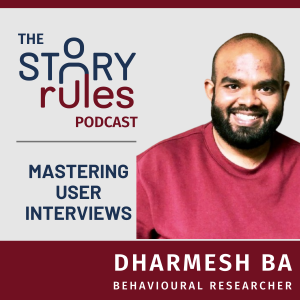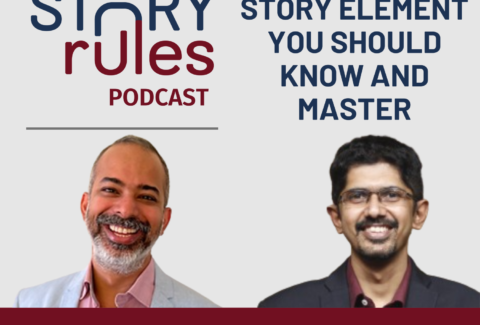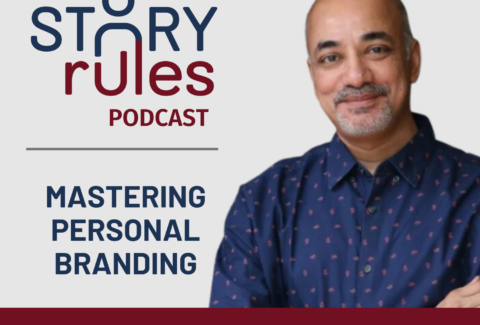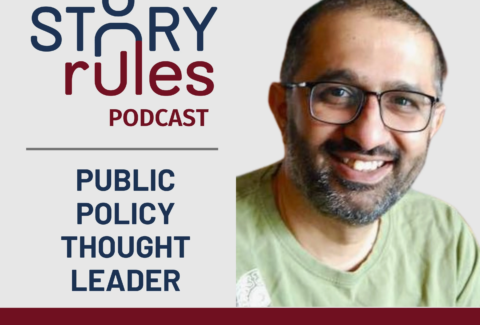The 7Cs Business Story Framework: the Hollywood Avatar
Earlier this week, I had posted an article on the 7Cs Story Framework, by analysing the storylines of super-hit Bollywood films. However this is not just an Indian phenomenon. These constructs are universal and Hollywood is also adept at using them for its blockbusters.
In this piece we will repeat the points made in the earlier article, but replace the movie examples with those from Hollywood. I have chosen some of the biggest hits for the analysis: Avatar, Star Wars and Finding Nemo.
If you had already read the previous article, you can directly go to the section on Hollywood movies 🙂
Is there one Story framework to Rule them All?
You have a big presentation coming up – pitching your product to a prospect, sharing a project success story, or just convincing your boss to approve a new training program.
You have your standard credentials deck/project presentation, but have the feeling that it is more snooze-inducing than approval-winning. The slides are filled with information, the flow doesn’t seem right and there’s too much “me” and too little “client/you”.
In today’s attention-deficit times, that approach cannot work. You can’t just inform – you have to engage.
Is there a way to persuasively structure your story such that:
- You position the client front and centre of the narrative
- The story ‘flows’ seamlessly, and
- The presentation retains the audience’s interest throughout
Inspiration from the movies
To answer this question, let’s take inspiration from another industry: movies. Surely we aren’t the first guys grappling with the issue of crafting a compelling story. Can we learn from good movies on how they do it? To put it in other words, is there a story formula/framework that is used by almost all successful movies?
Turns out, there is.
By applying this framework, your business presentations would become much more impactful, engaging and … what’s more – faster to create! A participant at a recent workshop told me “I wish I’d known this framework a few months back when I started work on my key presentation. I would’ve saved so much time”.
At this point you may be like: “Cut it out, just spill the beans”. I will, but not before asking you a simple question: Who or what is the Hero of your business story?
Who’s the Hero?
You are making a product presentation to a prospective client. Who or what is the hero of the deck? Is it:
- Your diagnosis of the problem your product solves
- The proposed solution (product)
- The client outcomes
- The underlying technology
The answer: None of the above.
A typical mistake we make in our presentations is to showcase ourselves as the hero, coming to the client’s rescue. This means the deck focuses on our history, our team, our experience, our reach, our outcomes – you get the drift.
But the client isn’t interested in our story – she wants to solve her issue.
We need to reframe our story by keeping the client at its front and centre – by positioning the client as the hero.
The Hero’s Journey
This brings us to a reputed, decades-old story framework: The Hero’s Journey¹, by Joseph Campbell, an American Professor of Literature who wrote about story structures.
When I heard about it, I looked it up and came across this:
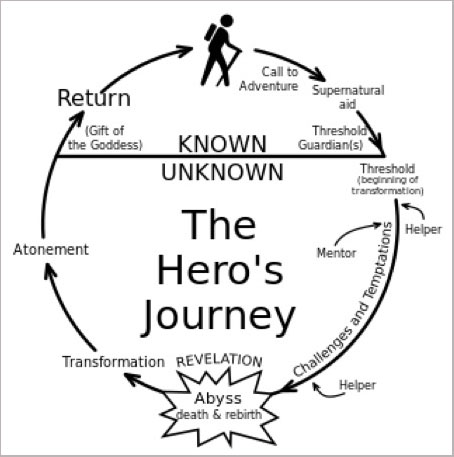

Hm, quite a mouthful, isn’t it? Not the easiest to understand.
So I decided to simplify it and adapt it for a business context: presenting the 7Cs Story Framework.
The 7Cs Story Framework
The 7Cs are: (Client) Context, Change, Conflict, Challenges and Counters, Conclusion and Call to Action
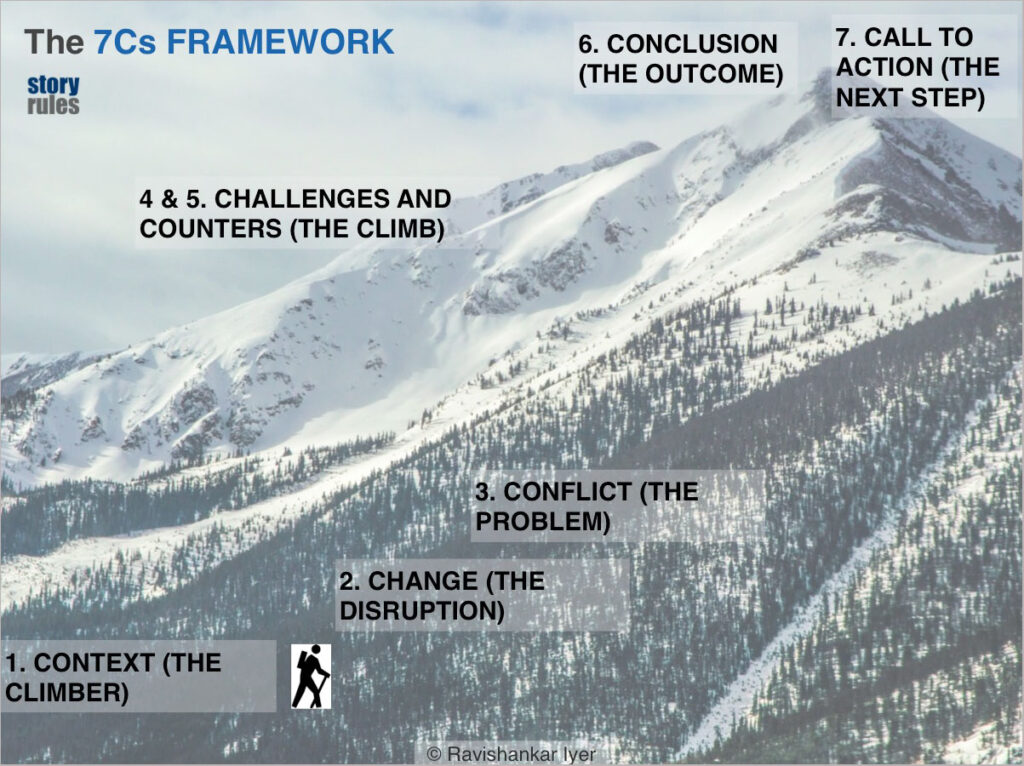

Applying the 7Cs Story Framework for Hollywood Movies
Let’s take some of Hollywood’s most successful movies – Avatar, Star Wars and Finding Nemo – and apply the model on them:
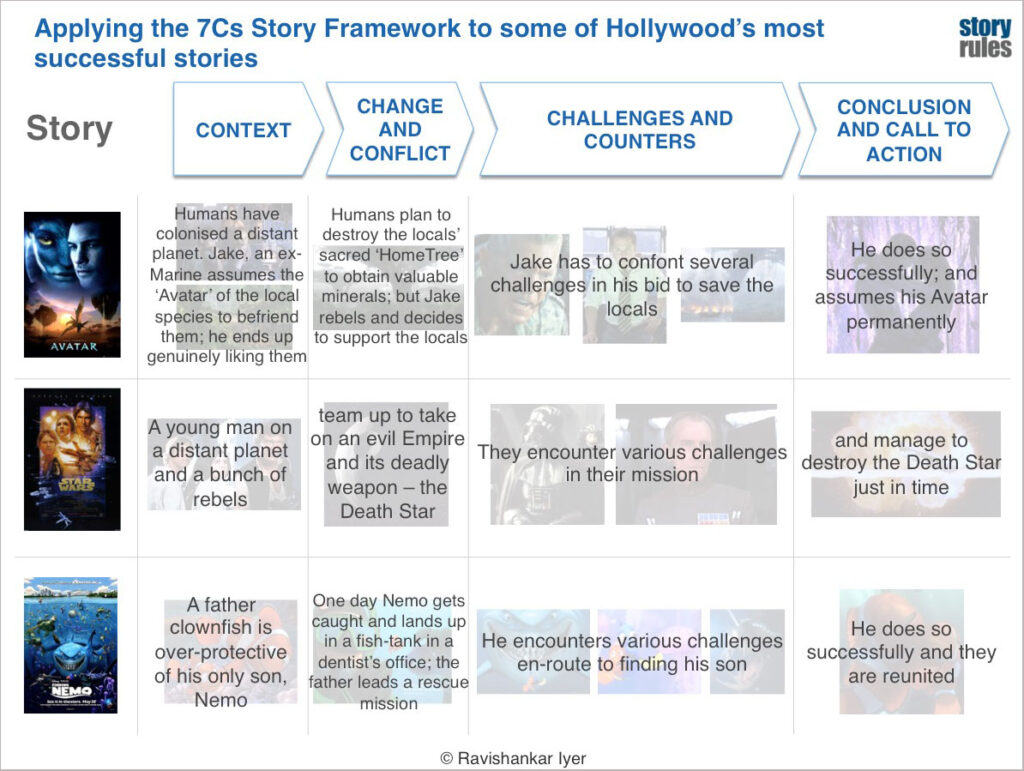

Isn’t it fascinating – these three blockbusters, which seem so different on the surface, all have a similar underlying structure? It’s like people having vastly different body types, facial features, hair… but a similar skeletal structure.
The Goal: Engaging your Attention
Why do such diverse blockbusters² follow a similar (not-so-secret) formula? The reason is simple: they want to hold your attention (in today’s attention-deficit-age). To do that, they use two devices:
- The Conflict: This is the binding thread that holds the entire movie together. In Avatar it is: Will Jake be able to save the locals or not? In Star Wars it is: Will Luke and the others be able to defeat the Empire and destroy the Death Star or not? And in Finding Nemo it is: Will Marlin and Dory be able to rescue Nemo or not? The conflict ensures that you are interested enough to watch the entire movie. However just one question cannot hold our attention for so many hours. Which is where the script-writers introduce the other device: challenges.
- The Challenges (and Counters): In trying to solve the conflict, the Hero would face many challenges (e.g. the HomeTree getting attacked, Han Solo’s ship getting captured by the Death Star, Marlin and Dory confronting the sharks and later the jellyfish). Each challenge is a question to the audience – how will the hero solve this puzzle? Each ‘Counter’ is the answer. And after all the counters, (usually) comes the happy ending – the Conclusion or resolution for the main Conflict.
The 7Cs Story Framework – applied for business
Now while it’s all fun and interesting to see this construct in movies, you may be thinking – heck, how can I use this at work?
For a business story, here’s how the 7Cs Story Framework looks:
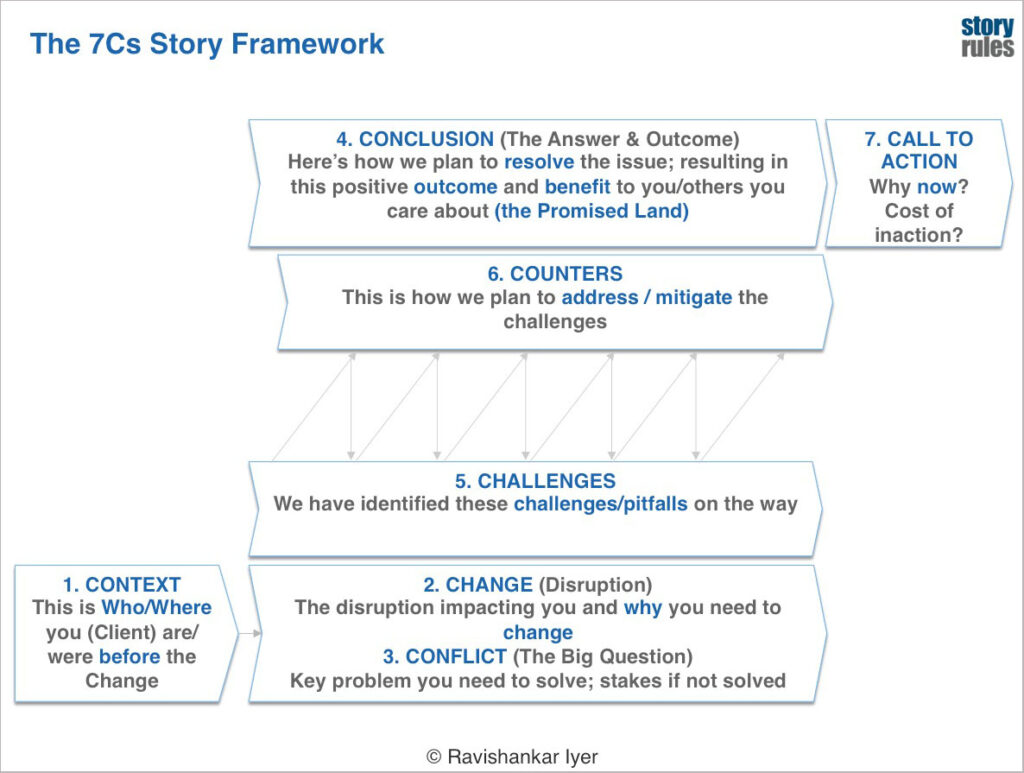

Let’s explain each ‘C’ in brief using a small case example: Samira, a senior sales leader at Abacus Tech, a healthcare IT company, was presenting to CHS, a US healthcare client which was considering setting up an advanced Business Intelligence (BI) system to manage its burgeoning data requirements. CHS’s President however, was a patient-and-employee-focused medico who was sceptical about technology and the need for a fancy new system.
Here’s how Samira can pitch to CHS:
- Context: This is the ‘business-as-usual’ scenario that the client (hero) was living in, before the change or disruption hit them. In a classic story, this is the “Once upon a time, there was a _________ and everyday he would _______” line. E.g. CHS is a leading healthcare system known for its focus on a superior patient experience. It leads the industry in patient and physician satisfaction metrics; however lags in technology adoption. (what is unsaid here is that: so far this tech-laggardness was ok and did not impact CHS adversely)
- Change: The change is an event which impacts the client. Changes could be sudden and dramatic (e.g. demonetisation); or an event which is known to be launched on a particular date (e.g. GST rollout). But most typically it’s an industry trend/process that plays out over a longer time period (it could be a few years, such as spread of smartphones, or a longer time period, e.g. the use of digital payments). Technology usually underlies almost all change. Most people are aware of such changes, but they tend to ignore/underestimate its impact. In case of CHS, the key industry trends impacting them are: healthcare data-explosion; higher patient expectations of customised care and the rising regulatory reporting requirements. Change is what makes the ‘business-as-usual’ approach redundant, risky or costly.
- Conflict: This is the central question which the hero needs to solve to address the impact of the change. A key sub-question that needs to be answered for the ‘conflict’ is the cost of inaction. What are the stakes? What would happen if status quo was maintained? Why should the client bother doing anything at all? Answers to these questions broadly come under two categories: fear and greed. Fear talks about what the client can lose out on (existing market share, relevance, regulatory costs), while greed explores what they stand to gain (new markets, leadership in a virgin space, cost savings). In case of CHS, the President’s heart beats for patients and employees. So the Conflict can be worded as: How can CHS deliver better patient care and employee experience (and derive other key benefits) by putting in place a state-of-the-art Business Intelligence system?
- Conclusion: Before describing the challenges and counters, it is useful to paint a picture of the ‘happy ending’ for the client. If the Conflict shows the cost of inaction (by painting a doomsday-ish scenario), the Conclusion draws the client towards itself and makes them want to undertake the journey. You need to show them the Promised Land. Make it as vivid as possible – tell it from the point of view of individual actors in the system, rather than at an overall level. A great example is this video for a bicycle store in the UK. In the CHS example, the Conclusion can be painted in terms of a pre-and-post scenario of much better experience of individual patients and hospital employees because of better predictive analytics, easier data retrieval and faster processes. Of course you need to also back this up with hard numbers – cost saving, potential new business, etc.
- Challenges: Once you’ve ‘sold’ the promised land, this section brings the client back to practical reality. Clearly the journey is not going to be easy. There would be multiple challenges: technical, financial, regulatory, people-related… The client needs to be aware of these, so that they know that they just can’t undertake the journey with any partner (or on their own). To successfully address the challenges, they need to identify the right partner for the journey. Which is where you come in (notice how late your entry into the story is). Here’s where we segue into the next section – your strengths in the form of special skill sets that enable the client counter the challenges. In the CHS case, the challenges could be: Presence of a complex legacy system; the need for a faster-than-normal rollout, given the upcoming centenary celebration; and a need for a multi-skilled workforce.
- Counters: In this section, you’ll state the counters planned for the identified challenges. You should also mention here, why you are best placed to support the client in this journey. Case studies of previous projects (your strongest suit), impact delivered, awards received, client testimonials – all of these need to make an appearance here, against the right challenge/counter. In the CHS case, your counters could be: Abacus has rich experience in handling similar complex legacy systems, as also projects with tight deadlines (give case studies for both) and it has one of the widest-array of skills in the industry, given specialisation in healthcare technology.
- Call to Action: Finally after explaining everything, there’s one place where the pitch can falter: at the last step when it lands in the zone of “we’ll think about it and get back to you, when we do it”. Many problems get solved only when they become really urgent. In your case, this is the section to answer the question: Why now? What is the cost of immediate inaction/delay? What if the client postpones it by six months? If your project genuinely has such a cost, then point it out. In the CHS example, Samira could end by saying: CHS has been a leader in patient care for almost a hundred years. For the upcoming centenary celebrations, it would be befitting to have a patient and doctor inaugurate the new BI system that would vastly improve their lives. If we decide to go ahead in the next couple of weeks, Abacus can ensure that the project is ready for launch in time.
So there you have it. For your next sales deck/project success story, position your client as the hero and show how they can undertake the journey through the 7Cs with your support to navigate the rough waters.
Feel free to reach out to me for help on your story structures. Happy storytelling!
*****
Featured image credit: Pixabay
Hero’s Journey: From Wikimedia by User: Slashme
All movie posters/images courtesy individual movies
- Needless to add, the word Hero is used in a gender-neutral context in this post
- Some of you may ask – surely not all super-hits follow this template; and there are many duds which might have done so. Is this framework really all that powerful? Fair point. Two counters: First, the template is just a skeleton; how you adapt it for each specific story also matters. Second, no story framework is a magic wand. All it does is (if implemented well) increase your odds of success. And in today’s competitive times that’s not a bad advantage to have. Clearly all these fine storytellers – like James Cameron, George Lucas and Pixar – seem to think so!



